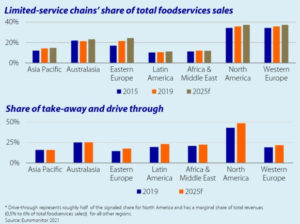
The selection of restaurant-branded foods in food retail is increasing, and the trend shows no signs of ending soon. This benefits both partners, and it meets consumer demand for convenience and availability of foodservice flavors, variety, and innovation.
In the past two years, the presence of foodservice-branded products in supermarkets has increased, as operators searched for alternatives to generate revenues and maintain brand visibility with closed doors. According to a recent Rabobank report, this trend is on the rise. In fact, new deals and agreements between retailers and restaurants are constantly being announced, even after the reopening of restaurants and bars.
Foodservice operators are developing strategies to adjust to the new demand derived from consumers’ changed behavior, such as the increased practice of working from home and greater appreciation of residential areas. “The post-pandemic resilience of delivery and take-away and the solid performance of foodservice operators in residential areas suggest that some of the changes triggered by Covid-19 may be structural, and, as result, new locations have gained traction,” explains Maria Castroviejo, Senior Analyst – Consumer Foods at Rabobank.
Leveraging the ample geographic coverage of food retailers, foodservice operators can expand into new areas while benefiting from the facilities and traffic already in place. Food retailers also benefit from this strategy, as it helps them retain the business that they gained in 2020 – which may otherwise return to foodservice – and it also allows them to adjust to an evolving consumer. Incremental revenues from new products, cross-selling, enhanced store image, and the benefits of relying on a professional partner help to minimize the difficulties of managing a very different activity.
Retail and foodservice are two very different businesses, and past failures evidence the significance of the challenge. “In-store experience, products, and services have to be consistent with the restaurant brand image, and the venture has to be profitable. But the choice of strategies and business models has grown and increased the opportunities to find a good fit,” says Castroviejo. Branded products in stores, serviced counters, dark kitchens, licensed products, central kitchens, self-run counters, franchises, and concessions are just some of the examples.
As boundaries between different food providers continue to blur, other players along the value chain will also be impacted. According to Castroviejo, opportunities for greater efficiencies in delivery and purchasing, as well as for supplying to both channels, aren’t going unnoticed.








